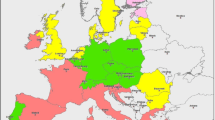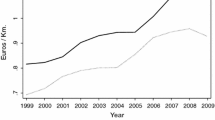Abstract
Longer and Heavier Vehicles (LHVs) could enhance the competitiveness of countries due to savings in transportation costs. However, the impact that this measure might have on the regional economic and on the transportation network remains unknown, since there is no methodology available to assess it. In this paper, we develop a new methodology based on a Random Utility-Based Multiregional Input–output Model and a road transport network model to assess the impact of allowing LHVs. We applied it to the case of Spain, and we found that allowing LHVs would produce both direct and indirect effects. Real GDP and employment are expected to grow in all the regions, but some of them —the most competitive, most peripheral, and most transport-intensive— will benefit much more than other regions. We also found that the measure would lead to a reduction of vehicles in the network and a reduction of emissions too. The approach designed in this paper provides broad guidance to national governments and other transport-related parties to quantify the impacts of transport policies such as this.




Similar content being viewed by others
References
Aurell J, Wadman T, Trucks V (2007) Vehicle combinations based on the modular concept. Nordiska Va gteknisk Fo rbundet (Nordic Road Assoc) 1(1):2007
Bereni M, Jacob B (2009) A look into the likely consequences of adapting weights and dimensions of heavy commercial vehicles in Europe. 2009 Annual Meeting of the Transportation Research Board of the National Academies, Washington, D.C., United States of America, pp 1–13
Bergqvist R, Behrends S (2011) Assessing the effects of longer vehicles: the case of pre- and post-haulage in intermodal transport chains. Transp Rev 31(5):591–602
Cascetta E, Marzano V, Papola A (2008) multi-regional input–output models for freight demand simulation at a national level. In: Ben-Akiva M, Meersman H, Van de Voorde E (eds) Recent developments in transport modelling: lessons for the freight sector. London
Caschili S, Medda FR, Wilson A (2015) An interdependent multi-layer model: resilience of international networks. Netw Spat Econ 313–335
Christidis P, Leduc G (2009) Longer and heavier vehicles for freight transport. Institute for Prospective Technology Studies (IPTS), Joined Research Centre (JCR), European Commission, Seville, pp 1–37
Clayton A, Montufar J, Middleton DR, Clayton A, Montufar J, Middleton DR (2007) In: Transportation Research Board TRB (ed) The operation of long semitrailers (57 to 60 feet) in the United States, 2007 annual meeting of the transportation research board. Transportation Research Board of the National Academies - TRB, Washington
De Ceuster G, Breemersch T, Van Herbruggen B, Verweij K, Davydenko I, Klingender M, Jacob B, Arki H, Bereni M (2008) In: I. & C. European Commission - Directorate General Energy and Transport - Unit Logistics (ed) Effects of adapting the rules on weights and dimensions of heavy commercial vehicles as established within directive 96/53/EC TREN/G3/318/2007. TML, TRANSPORT & MOBILITY LEUVEN, Brussels, pp 1–315
De Jong G, Gunn H, Walker W (2004) National and international freight transport models: an overview and ideas for future development. Transp Rev 24(1):103–124
De Palma A, Kilani M, Lindsey R (2008) The merits of separating cars and trucks. J Urban Econ 64(2008):340–361
Debauche W (2006) Working Group on Longer and Heavier Goods Vehicles: A Multidiciplinary Approach to the Issue. In: Jacob B, Nordengen P, O’Connor A, Bouteldja M (eds) International conference on heavy vehicles - 10th heavy vehicle transport technology - 5th weight in motion. ENPC, Marne-la-Vallée, Paris, pp 81–90
Doll C, Fiorello D, Pastori E, Reynaud C, Klaus P, Lückmann P, Hesse K, Kochsiek J (2009) Long-term climate impacts of the introduction of mega-trucks study to the community of european railways and infrastructure companies (CER). The Fraunhofer-Institute for Systems and Innovation Research (ISI), Karlsruhe, pp 1–156
Du X, Kockelman KM (2012) Tracking transportation and industrial production across a nation. Transp Res Rec: J Transp Res Board, Washington DC, US 2269:99–109
Eidhammer O, Sorensen M, Andersen J (2009) Longer and heavier goods vehicles in Norway. Status by October 1st. 2009. In: The Institute of Transport Economics T. Ø. I. report 1040/2009. Oslo, pp 1–5
Ericson J, Gunnar L, Mellin A, Vierth I (2010) Co-modality – the socio-economic effects of longer and/or heavier vehicles for land-based freight transport. 12th World Conference on Transport Research Society, Selected Proceedings of the 12th World Conference on Transport Research Society. Lisbon
European Commission EC (1996) DIRECTIVE 96/53/EC Road Vehicles authorized dimensions in national and international traffic and the maximum authorized weights in international traffic. Brussels, pp 1–17
European Commission EC - Directorate-General for Mobility and Transport (2012) Road transport - a change of gear. Road, European Commission, Luxembourg, pp 1–20
EUROSTAT (2012) Modal Split of Freight Transport Modal split of freight transport. European Commission. <http://epp.eurostat.ec.europa.eu/tgm/refreshTableAction.do?tab=table&plugin=1&pcode=tsdtr220&language=en>
Fundación de los Ferrocarriles Españoles, and Ministerio de Fomento (2011) Informe 2010 - Observatorio del Ferrocarril en España. Documento de Trabajo 2011. Madrid, pp 1–231
Grange L, Ibeas A, González F (2011) A hierarchical gravity model with spatial correlation: mathematical formulation and parameter estimation. Netw Spat Econ 11(3):439–463
Gutierrez J, Condeço-Melhorado A, Martin JC, Román C (2012) Impacto de la tarificación en carreteras en el acceso a los mercados: El caso de la euroviñeta, XVII Congreso Panamericano de Ingeniería de Tránsito, Transporte y Logística, Congreso Panamericano de Ingeniería de Tránsito. Transporte y Logística, Santiago de Chile, Chile, pp 1–20
Guzman AF, Vassallo JM (2014) A methodology for assessing regional economic impacts of charging HGVs in Spain : an integrated approach through a random utility based multiregional input–output and a road transportation network model. Transp Res Rec: J Transp Res Board, Washington DC, US 2378:129–139
Holguín-Veras J, Patil GR (2008) A multicommodity integrated freight origin–destination synthesis model. Netw Spat Econ 8(2–3):309–326
Holguín-Veras J, Thorson E, Zorrilla JC (2010) Commercial vehicle empty trip models with variable zero order empty trip probabilities. Netw Spat Econ 10(2):241–259
Ittershagen M (2007) Longer and heavier on german roads. Do Megatrucks contribute towards sustainable transports. Dessau, pp 1–6
Janic M (2007) Modelling the full costs of an intermodal and road freight transport network. Transp Res Part D: Transp Environ 12(1):33–44
Jiang X, Zhang L, Xiong C, Wang R (2015) Transportation and regional economic development: analysis of spatial spillovers in China Provincial Regions. Netw Spat Econ
K+P, Transport Consultants, and Fraunhoffer ISI (2011) Study on the effects of the introduction of LHVs on combined road-rail transport and single wagonload rail freight traffic. Freiburg/Karlsruhe, pp 1–117
Kim NS, Van Wee B (2011) The relative importance of factors that influence the break-even distance of intermodal freight transport systems. J Transp Geogr 19(4):859–875
Kindt M, Burgess A, Groen R (2011) Longer and heavier vehicles in practice - economic, logistical and social effects. Colofon, Ministry of Transport, Public Works and Water Management, Amsterdam, pp 1–114
Knight I, Newton W, McKinnon AC, Palmer A, Barlow T, McCrae I, Dodd M, Couper G, Davies H, Daly A, McMahon W, Cook E, Ramdas V, Taylor N (2008) Longer and/or longer and heavier goods vehicles (LHVs) – a study of the likely effects if permitted in the UK: final report. TRL Limited, Crowthorne, pp 1–332
Kockelman KM (2008) Documentation for application of random-utility-based multi-regional input–output (RUBMRIO) model
Kockelman KM, Huang T (2007) The Introduction of dynamic features in a random-utility-based multiregional input–output model of trade, production, and location choice. 2007 Annual Meeting of the Transportation Research Board of the National Academies, Washington, D.C., pp 1–23
Leduc G (2009) Longer and heavier vehicles: an overview of technical aspects, JRC scientific and technical reports. European Commission - Joint Research Centre - Institute for Prospective Technological Studies, Seville, pp 1–49
Leontief WW (1986) Input–output economics, Scientific American. Oxford University Press, New York, pp 1–430
Lukason O, Ukrainski K, Varblane U (2011) Economic benefit of maximum truck weight regulation. Discuss Estonian Econ Policy 2(2011):87–100
Marzano V, Papola A (2008) A multi-regional input–output model for the appraisal of transport investments in Europe, European transport conference 2008. Association for European Transport, The Netherlands, pp 1–12
McFadden D (1977) Quantitative methods for analyzing travel behavior of individuals: Some recent developments. In: Hensher DA, Stopher PR (eds) Behavioural travel modelling. Croom Helm London, London, pp 279–318
McKinnon AC (2008) In: Pawar K, Lalwani CS, Banomyong R (eds) Should the maximum length and weight of trucks be increased? A review of european evidence, 13th International Symposium on Logistics - ISL 2008. Centre for Concurrent Enterprise, Bangkok, pp 587–594
Ministerio de Fomento - MFOM (2007a) Encuesta Permanente de Transportes de Mercancías por Carretera 2007. In: Dirección General de Programación Económica del Ministerio de Fomento. Madrid, pp 1–206
Ministerio de Fomento - MFOM (2007b) Mapa de Tráfico 2007. Estadísticas y Publicaciones, Centro de Publicaciones, Ministerio de Fomento, Madrid
Ministerio de Fomento - MFOM (2011a) Encuesta Permanente de Transporte de Mercancías por Carretera 2010. Serie Estadísticas. In: Dirección General de Programación Económica y Presupuestos. Madrid, pp 1–226
Ministerio de Fomento - MFOM (2011b). Proyecto DESTINO - Desarrollo de Metodologías de Evaluación del Impacto Económico del Sistema de Transportes Mediante Tablas Input–output Interregionales. (P42/08). Universidad Autónoma de Madrid - Universidad Politécnica de Madrid, Universidad Complutense de Madrid, Madrid
Novak DC, Hodgdon C, Guo F, Aultman-Hall L (2011) Nationwide freight generation models: a spatial regression approach. Netw Spat Econ 11(1):23–41
Ogburn M, Ramroth L, Lovins AB (2008) Transformational trucks : determining the energy efficiency limits of a class-8 tractor-trailer. US. The Rocky Mountain Institute, Colorado
Ortega A, Vassallo JM, Guzmán AF, Pérez-Martínez PJ (2014) Are longer and heavier vehicles (LHVs) beneficial for society? A cost benefit analysis to evaluate their potential implementation in Spain. Transp Rev 34(2):150–168
Ortúzar J d D, Willumsen LG (2011) Modelling transport, 4th edn. Wiley, London
Parsons Brinckerhoff Quade & Douglas Consult - PB, AECOM, Urbitran Associates Inc., Urbanomics Associates & Alex Anas International, NuStats, and Inc., G H & A (2005) New York Best practice model (NYBPM). New York
Samuel P, Poole RW, Holguin-Veras J (2002) Toll truckways: a new path toward safer and more efficient freight transportation. Los Angeles, pp 44.
Tavasszy LA (2006) Freight modeling - an overview of international experiences, TRB conference on freight demand modeling: tools for public sector decision making. Transportation Research Board, Washington DC, pp 1–12
TMIP (2010) Travel model validation and reasonability checking manual second edition. Federal highway administration, travel model improvement program. Cambridge, pp 1–240
Verweij K, Davydenko I (2010) Estimation of the Impact of Long and Heavy Vehicles on Future Transport Demand and Modal Shift. In: Milne P, Germanchev A (eds) 11th Heavy Vehicle Transport Technology. Melbourne, pp 1–11
Vierth I, Berell H, McDaniel J, Haraldsson M, Hammarström U, Yahya M-R, Lindberg G, Carlsson A, Ögren M, Björketun U (2008) The effects of long and heavy trucks on the transport system - report on a government assignment. VTI rapport 605A. Ministry of Enterprise, Energy and Communications, Linköping, pp 1–92
Wegener M (2004) Transport Geography and Spatial Systems: Overview of Land-Use Transport Models. In: Button KJ, Hensher DA (eds) Handbook in transport. Pergamon/Elsevier Science, Kidlington, pp 127–146
Ye X (2010) Accelerated procedure of multiclass highway traffic assignment for Maryland. 2010 Annual Meeting of the Transportation Research Board, of the National Academies, Washington, D.C., pp 1–15
Zhao Y, Kockelman KM (2004) The random-utility-based multiregional input–output model: solution existence and uniqueness. Transp Res B Methodol 38(9):789–807
Acknowledgments
The authors acknowledge the Research Ministry (MICINN) for its support in funding the research project on the interregional input–output table approach to assess the effects of a transport policy measure (DESTINO). The authors are grateful to the anonymous reviewers for their useful comments and suggestions.
Author information
Authors and Affiliations
Corresponding author
Rights and permissions
About this article
Cite this article
Guzman, A.F., Vassallo, J.M. & Hortelano, A.O. A Methodology for Assessing the Regional Economy and Transportation Impact of Introducing Longer and Heavier Vehicles: Application to the Road Network of Spain. Netw Spat Econ 16, 957–979 (2016). https://doi.org/10.1007/s11067-015-9305-7
Published:
Issue Date:
DOI: https://doi.org/10.1007/s11067-015-9305-7




